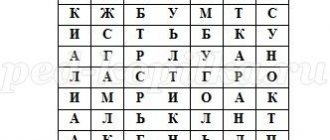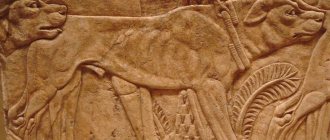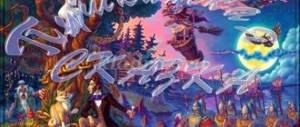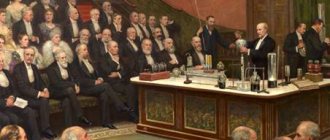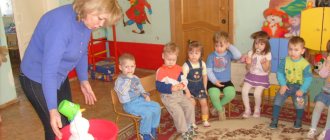Riddles about folk crafts with answers for preschool children
RIDDLES ABOUT FOLK CRAFTS with answers for kindergarten
Sredina Olga Stanislavovna teacher, head of the art studio of the Central Children's Educational Institution No. 1 “Bear Cub”, Yuryuzan, Chelyabinsk region. Goals: acquaintance of preschoolers with folk crafts Tasks - to develop aesthetic taste, a sense of beauty - to teach ways to distinguish various folk crafts from each other - to cultivate a sense of patriotism Explanation These riddles were published in the magazine “Preschool Education” No. 5 for 1997 (pp. 40-42 ). They were an appendix to my script, but after some time they began to appear in various materials without a signature. I am pleased that they “went to the people,” but with this publication I would like to remind you that riddles have an author. We use them for classes and entertainment. Collected in a booklet, they become a pleasant gift for graduates. I hope they will be useful to many colleagues. RIDDLES ABOUT FOLK CRAFTS 1 These figurines are very heavy: Girls, boys, horse sculptures. There are also candlesticks and carved dishes. Well, guess where these come from? (Kasli casting)
2 Knock-knock, click-click, Bear, man, goat and wolf Wooden toys And bears and old women Sometimes they sit, sometimes they rush The kids will make everyone laugh (Bogorodskaya carving)
3 Snow-white dishes, Tell me where are you from? Apparently, she came from the north and blossomed with blue, blue, tender, beautiful flowers. (Gzhel)
4 Carved spoons and ladles Take a look, don’t rush. There the grass curls and flowers grow of unearthly beauty. They sparkle like gold, or maybe they're sunlit. (Khokhloma)
5 Cheerful white clay, Circles, stripes on it. Funny goats and lambs, A herd of colorful horses, Nurses and water-carriers, And horsemen and children. Dogs, hussars and fish... Come on, name me! (Haze)
6 Round, iron, useful in the household. Black, yellow, red Amazing and beautiful! (Zhostovo trays)
7 We were blinded by masters, it’s time to paint us! Horses, young ladies, lambs Long-necked and slender. Blue-red stripes are visible on our sides. (Filimonov toys)
8 The girlfriends are different in height, they all look alike. One, two, three, four, five... You can’t even count them all! The old lady looked at her and in her hands was just a toy. (Matryoshka dolls)
9 An iron plate, On it is a simple landscape: Birches and rowan trees, Mountains of distant ridges. (Zlatoust engraving)
10 Boards are made of linden, and spinning wheels and horses. Painted with flowers, like shawls. There horsemen gallop dashingly, Firebirds fly high. Black and white animations sparkle in the sun. (Gorodets)
11 Barrels, piggy banks, nesting dolls, mushrooms. They are not small, nor are they large. Whistles, plates in bright colors And the sun and the river and a house in the bushes. Free painting: the rose hips are blooming, and the apples are ripening and the grass is growing. Flowers are drawn with ink on the stems. Their bright colors are rich and simple. (Polkhovsky Maidan)
12 The bobbins are knocking: knock, knock, knock - The handkerchief suddenly appeared. And the collar is made of white thread, beautifully made, take a look! (Vologda lace)
13 On a black background - red roses, lilies, poppies, daisies, snowdrops. The girls' heads are tied with them, their eyes are sly, their faces are tender. (Pavlovo shawls)
We recommend watching:
Riddles about animals for children with answers Riddles about plants with answers for children Riddles about toys with answers for children from 4 years old Riddles about animals with answers for children 5-6 years old
Similar articles:
Riddles about professions for children
Riddles with answers about winter for children
Riddles about the New Year
Riddles about autumn
Riddles about flowers and plants with answers
Russian crafts and trades
Our class hour is dedicated to folk crafts and crafts. Let's learn about folk art.In the old days, everything was done with your own hands. Crafts fed, clothed and provided shoes. No wonder the Russian proverb says: “Craft is not a rocker - it doesn’t pull your shoulders, but feeds itself.”
Ready to get started?
Then, you must guess my riddle, and there will be a clue on the board. I will show the item, and your task is to say what it is and what it was used for.
I'm made of fluffy wool
I'll get some yarn for you.
I'll roll it all up into balls
and tie my socks,
or a warm shirt,
because…
Spinner
Hand spinning
has been known for a long time. It was common among all peoples of the globe, with the exception of the far north, where fur clothes were worn. The first spinning tools were hand combs for combing fibers and hand spindles for twisting them.
In the 15th century, a self-spinning wheel with a flyer was invented, which made it possible to simultaneously twist and wind yarn.
Since the 18th century, machine spinning has been developing. Electric spinning wheels are widely known today.
And you will find out what kind of craft we are talking about now by guessing the riddle: Two cheerful sisters - Craftsmen of all trades: They will make Socks and mittens from a thread.
Of course, we will talk about knitting
. When the art of knitting appeared is unknown. Sheep were domesticated as early as 9000 BC. In Russia, these animals, and with them the art of knitting, appeared at the end of the 18th century. Gatherings in Rus', which began with the Intercession, were unthinkable without this craft. The younger ones knitted (the older ones wove or spun), providing the whole family with socks, mittens and scarves.
Knitted products have always been popular. They have not gone out of fashion today. Hand knitted clothes are unique.
And now it’s the turn of a new craft. If you guess the riddle, you will recognize him:
Do you need a rug
or the fabric is beautiful,
I'll make it in a jiffy.
I manage recklessly
My craft...
Weaver.
Weaving.
The loom is one of the most ancient tools of human labor, and weaving is one of the most ancient crafts.
In the 11th century, a horizontal loom was invented, which, with minor changes, has survived to this day and is still preserved in some houses.
Then people invented the power loom. Nowadays, modern weaving looms run on electricity and have become more complex and varied. But hand weaving is still alive and is a traditional folk craft.
Among household weaving products one can highlight linen patterned tablecloths, tabletops, towels, elegant valances, rugs, runners, bedspreads, elements of women's costume
Calm moments flowed by, Under a thin, deft needle With love, tenderness, patience, the Pattern was born by itself.
Embroidery
.The art of embroidery dates back centuries. In Ancient Rus', the clothes of noble people and household items were decorated with gold embroidery. Embroidery is done using a needle on various fabrics using threads of flax, hemp, silk, wool, silver, gold, and precious stones. Russian embroidery had its own characteristics. It often used geometric patterns, images of women, trees, birds, and vegetation. Characteristic embroidery is cross stitch, cutout, satin stitch.
We talked about crafts, and now we’ll learn about trades.
1) Gzhel Gzhel is a folk ceramic craft. Gzhel is known and popular not only in Russia, but also far beyond the country’s borders. The traditional ornament decorating porcelain products is blue and light blue flowers, leaves, cereals, and a Gzhel blue rose. 2) Khokhloma In the city of Semenov, which is located in the Nizhny Novgorod region, since ancient times wooden utensils have been decorated with painting. This is how “Golden Khokhloma” appeared - the art of painting with paints on wood. A special varnishing technology imparts elegance and special color to wood products. By drying the varnished product in ovens at high temperatures, the product acquires a special golden-honey hue. 3) Russian matryoshka
The symbol of Russian artistic crafts has become the Matryoshka - a wooden toy in the form of a set of several painted dolls, hollow inside. 4) Orenburg down scarf Knitted scarves made from goat down are an ancient craft that originated in the Orenburg region 250 years ago. Handmade scarves, knitted by craftswomen, are light as feathers and warm as the palms of a mother. 5) Dymkovo toy Sloboda Dymkovo, Vyatka province (now Kirov region) became the birthplace of clay toys, painted and baked in a kiln. Dymkovo clay toy is a symbol of Russian craft. And now I want to find out how you listened to me and ask you riddles.
Take a look at the carved spoons and ladles, don’t rush. There the grass curls and flowers grow of unearthly beauty. They sparkle like gold, or maybe they're sunlit. (Khokhloma)
Cheerful white clay, Circles, stripes on it. Funny goats and lambs, A herd of colorful horses, Nurses and water-carriers, And horsemen and children. Dogs, hussars and fish... Come on, name me! (Haze)
Snow-white dishes, Tell me where are you from? Apparently, she came from the north and blossomed with blue, blue, tender, beautiful flowers. (Gzhel)
The fat woman is bought, In the middle it opens - The nephew smiles. The nephew opens - the granddaughter fits in it. What is your aunt's name?
All-Russian educational quiz “Journey through Russian folk crafts”
Regulations on holding the All-Russian educational quiz for preschoolers and schoolchildren “A Journey through the Folk Crafts of Russia”
1. General position
1.1. These Regulations determine the conditions for organizing and conducting the All-Russian educational quiz for preschoolers and schoolchildren “A Journey through the Folk Crafts of Russia”
1.2. This quiz is a remote form of organizing cognitive and creative activities aimed at the development of preschoolers and schoolchildren and is held on the Internet at https://www.strana-voprosov.ru/ The territory where the quiz is held is the Russian Federation
1.3. The initiator and organizer of the quiz is the Education Development Center “Land of Questions”
2. Goals and objectives of the quiz:
— disclosure of intellectual abilities, broadening of horizons;
- consolidate the names and features of various types of painting;
— the opportunity to compete on a scale that extends beyond the educational institution and region.
3. Timing of the quiz
The quiz period is from March 15, 2020 to March 15, 2020 (inclusive).
Summing up the quiz daily
4. Quiz participants:
4.1. Pupils of any preschool institutions in the Russian Federation
4.2. Students of schools, lyceums, gymnasiums and other educational institutions.
4.3. Children not attending educational institutions.
5. Quiz procedure:
5.1.Register on our website (a teacher or parent can register)
If you have registered previously, re-registration is not required!
The video instruction “How to register a “Personal Account” will help you with registration.
5.2.Pay the registration fee for participation in the quiz - 100 rubles for participation in one quiz per participant
(Payment is made online in your “Personal Account”. To do this, you need to top up your “Wallet” with at least 100 rubles; after passing the quiz, funds in the amount of 100 rubles will be automatically debited from your “Wallet” in your “Personal Account”)
In the “Video Instructions” section there is a detailed video on how to replenish your “Wallet” and write off funds for participating in the quiz. Before paying, please watch this video!
5.3. Go to the “Events” section, select the desired category and quiz.
Carefully fill out all the fields of the form (IN THE “GROUP/CLASS” COLUMN, DO NOT JUST WRITE A PREPARATORY OR A NUMBER, ENTER THE WORD GROUP OR CLASS, ALSO IN THE “CITY” COLUMN, WRITE BEFORE THE NAME OF THE LOCATION - CITY, VILLAGE, TOWNSHIP, etc.)
If you want to receive a diploma not only as a participant, but also as a teacher, be SURE to fill out the data in the form for a teacher!!!
We kindly request! Please fill out the participant form very carefully! Please indicate your full name, educational institution and city correctly. All data is transferred to the diploma! There will be no opportunity to correct the data in the diploma!
5.4. Answer the quiz/olympiad questions carefully! After all the answers are highlighted, click on the “Take Quiz” button
6. Summing up the results of the quiz and rewarding the participants:
6.1. Based on the results of the quiz, participants score points:
No mistakes - 1st place
1 mistake - 2nd place
2 mistakes – 3rd place
3 mistakes or more – Winner
6.2. Based on the results of the quiz, participants are awarded Diplomas of Laureates of the All-Russian Quiz.
Teachers who prepared the Winner or Laureate of the quiz are awarded personalized Teacher Diplomas FREE OF CHARGE!!! (provided that the teacher’s information was filled out in the form)
6.3. The results of the quiz are published in the “Results” section!
6.4. Award documents are available for downloading in your “Personal Account”, as well as in the “Results” section IMMEDIATELY AFTER COMPLETING THE QUIZ!

